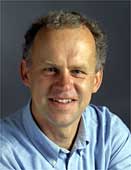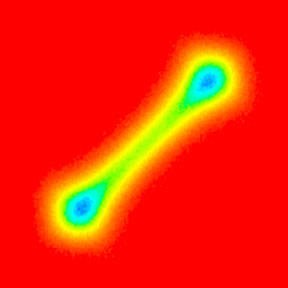
| Physics | ||
|
Summary of the research Interview for "New Knowledge" The step between theory and experiment can be a long step indeed. At times it could appear insurmountable. With the aid of computer simulations, however, a fruitful intermediate stage can be created. This is something that Göran Wahnström, a theoretician who has become interested in reality, finds appealing. During his time as a doctoral student there was no doubt whatsoever that it was the theory that interested him most. There was definitely a certain pleasure to be had in dealing with a good, simple theory. But then something happened. "You could say that I wanted to see how things were in reality without having to perform an experiment." Computer simulations bring this idea closer. Certain people call it the third way of working with physics in addition to theory and experiment. Improved computer capacity has now made it possible to run effective simulations on the computer. You either set up a highly-simplified model with ideal conditions or you endeavour to imitate actual systems as closely as possible. You are always compelled to make a series of simplifications or approximations, although the increase in computer power allows more exact, reality-based calculations to be made. Calculations involve a great deal of work and Göran Wahnström believes that his doctoral students spend almost 90% of their time at the computer. Chalmers' powerful parallel computer is used a great deal. "The aim is to find a simple model - the one you can explain over a cup of coffee," he says. "That's what we are trying to find although it is proving very difficult." Within materials and surface theory the focus of Göran Wahnström's work is more on the materials side. At present, he has a research position financed by the Swedish Research Council, which he will hold for a further four years. The focus is basic research into hydrogen and hydrogen-related problems. One of the areas addressed in the studies is the way in which hydrogen diffuses on surfaces. At low temperatures the hydrogen can 'tunnel' quantum-mechanically. Together with his colleagues he has examined this type of process using the so-called Monte Carlo method, where random numbers are used regularly. Knowledge of the behaviour of hydrogen, particularly its interaction with other substances, is of considerable interest in many areas, including applied research into fuel cells and catalysis.
An interesting new development is the fact that parts of theoretical physics are attracting interest in the engineering industry, including stimulating challenges within materials science. There is, for example, a direct need to know what actually happens in hard metals used in cutting tools. When these tools are exposed to high loads and high temperatures the shape can be changed – plastically deformed – making them unusable. It is believed that this can be attributed to the fact that the so-called grains in the material begin to slide towards each other. What is needed is knowledge of how the atoms adhere to each other. This is exactly what Göran Wahnström and his colleagues are working on. "At the same time it is both gratifying and stimulating that interest from external financing bodies is increasing," states Göran Wahnström. "This involves striking a good balance with our basic work. "One must not forget to develop models and theories. Building up new knowledge is the raison d'être for Chalmers as a university. It is then up to others to come in when this new knowledge is to be put into practice. Correctly-educated people can also be seen as being that the most important 'product' to come from here." The driving force in his role as a researcher is to be found in motivating students to continue their search for knowledge and to then send them out to work for the benefit of society. "It's fun to explain," says Göran, who previously taught a great deal but now, with this special position, he only has one course during the fourth year. However, the challenge of guiding doctoral students towards their PhD still remains and although extremely demanding both personally and in terms of knowledge, it is nevertheless highly rewarding. Sofie Hebrand |
||
Last updated: November 2001 If you wish to order "New Knowledge" Installed professors 2001 To the menu of the Research profiles at Chalmers To Chalmers Home-page About www.chalmers.se |
 Göran Wahnström was
appointed Professor of Physics on July 1, 2001. He was born in
Jönköping in 1955 and graduated from Chalmers University of Technology
in 1979 with an MSc in Engineering Physics. He obtained his PhD in
Theoretical Physics in 1985 and became 'docent' in 1989 and professor
(biträdande) in 1996. He has been a post-doc in the USA for two years.
Since 2000 he has held a Senior Research Position at the Swedish
Research Council (VR) and at present he is programme leader for
ATOMICS, a materials science program supported by the Swedish
Foundation for Strategic Research (SSF).
Göran Wahnström was
appointed Professor of Physics on July 1, 2001. He was born in
Jönköping in 1955 and graduated from Chalmers University of Technology
in 1979 with an MSc in Engineering Physics. He obtained his PhD in
Theoretical Physics in 1985 and became 'docent' in 1989 and professor
(biträdande) in 1996. He has been a post-doc in the USA for two years.
Since 2000 he has held a Senior Research Position at the Swedish
Research Council (VR) and at present he is programme leader for
ATOMICS, a materials science program supported by the Swedish
Foundation for Strategic Research (SSF).